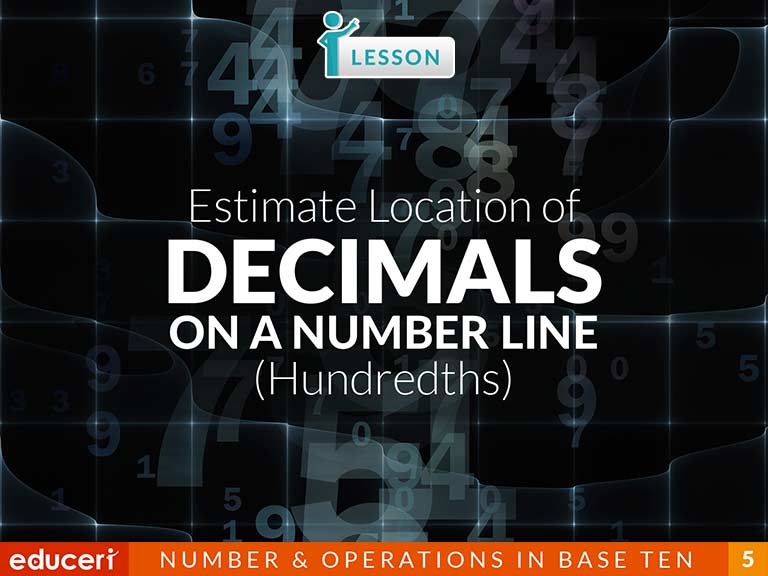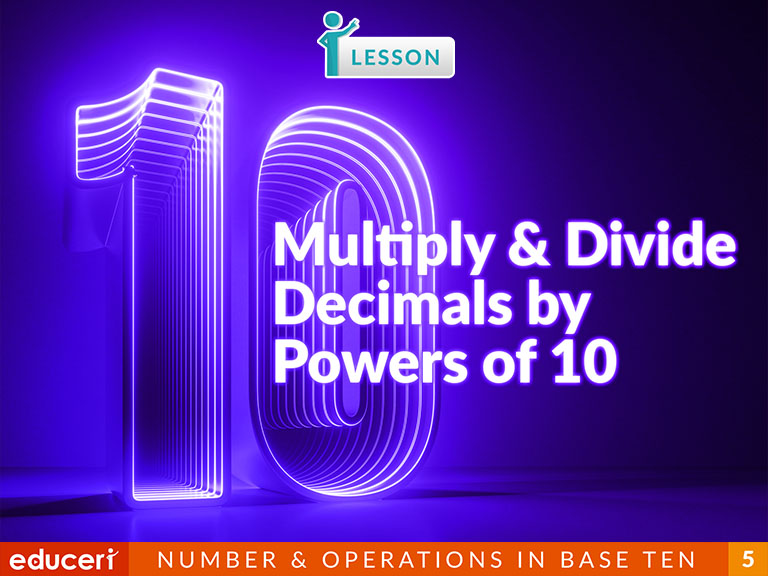All Lessons

Divide Decimal Numbers
(F) Represent quotients of decimals to the hundredths, up to four-digit dividends and two-digit whole number divisors, using objects and pictorial models, including area models
5.3.G(G) Solve for quotients of decimals to the hundredths, up to four-digit dividends and two-digit whole number divisors, using strategies and algorithms, including the standard algorithm
This number sense lesson focuses on dividing decimal numbers. The lesson includes research-based strategies and strategic questions that prepare students for assessments. In this lesson, students change the problem into long division form, if necessary, and move the decimal point in the divisor to change it to a whole number, if necessary. Then, move the decimal point in the dividend the same number of places. Finally, they divide the decimal numbers and put a decimal point in the quotient above the decimal point in the dividend. In addition to the lesson, there are four pages of Independent Practice and Periodic Reviews with questions modeled after current adaptive testing items and eight flash cards on changing to long division form.
Share This Lesson

Multiply Decimal Numbers
(D) Represent multiplication of decimals with products to the hundredths using objects and pictorial models, including area models
5.3.E(E) Solve for products of decimals to the hundredths, including situations involving money, using strategies based on place-value understandings, properties of operations, and the relationship to the multiplication of whole numbers
This number sense lesson focuses on multiplying decimal numbers. The lesson includes research-based strategies and strategic questions that prepare students for assessments. In this lesson, students multiply the bottom factor with each digit of the top factor, regrouping if needed. Then, they count the total number of decimal places in the two factors and place a decimal in the product that many places to the left. In addition to the lesson, there are four pages of Independent Practice and Periodic Reviews with questions modeled after current adaptive testing items.
Share This Lesson

Subtract Decimal Numbers
This number sense lesson focuses on subtracting decimal numbers. The lesson includes research-based strategies and strategic questions that prepare students for assessments. In this lesson, students identify the numbers that are being subtracted, if needed. Then, they line up the decimal numbers by place value, making sure the decimal points line up. Finally, they subtract, line up the decimal point in the difference, and interpret the difference. In addition to the lesson, there are eight pages of Independent Practice and review with questions modeled after current adaptive testing items.
Share This Lesson

Estimate Location of Decimals on a Number Line (Hundredths)
This number sense lesson focuses on identifying decimals on a number line. The lesson includes research-based strategies and strategic questions that prepare students for assessments. In this lesson, students read the question and identify which whole numbers the decimal is more than and less than. They do that by locating the closest point that is between those whole numbers. finally, they circle the correct answer. In addition to the lesson, there are eight pages of Independent Practice and review with questions modeled after current adaptive testing items.
Share This Lesson

Subtract Fractions with Unlike Denominators
This number and operations--fractions lesson teaches students how to subtract fractions with unlike denominators. The lesson includes research-based strategies and strategic questions that prepare students for assessments. In this lesson, students create equivalent fractions to subtract fractions with unlike denominators. Reducing the results is not addressed. This lesson focuses on unlike denominators that require both fractions to be changed.
Share This Lesson

Interpret Fractions as Divisions
This number sense lesson focuses on showing common decimal numbers as percents. The lesson includes research-based strategies and strategic questions that prepare students for assessments. In this lesson, students read the question and change the decimal number into a fraction with a denominator of 100 using a place value chart. Then, they change the fraction into a percent and interpret the result. In addition to the lesson, there are four pages of Independent Practice and Periodic Reviews with questions modeled after current adaptive testing items.
Share This Lesson

Multiply Fractions
5.NF.4 Apply and extend previous understandings of multiplication to multiply a fraction or whole number by a fraction.
5.NF.4.A5.NF.4.A Interpret the product (a/b) × q as a parts of a partition of q into b equal parts; equivalently, as the result of a sequence of operations a × q ÷ b. For example, use a visual fraction model to show (2/3) × 4 = 8/3, and create a story context for this equation. Do the same with (2/3) × (4/5) = 8/15. (In general, (a/b) × (c/d) = (ac)/(bd).
This lesson addresses fraction multiplication at the fluency level.
Share This Lesson

Divide Unit Fractions by Whole Numbers
(J) Represent division of a unit fraction by a whole number and the division of a whole number by a unit fraction such as 1/3 ÷ 7 and 7 ÷ 1/3 using objects and pictorial models, including area models
5.3.L(L) Divide whole numbers by unit fractions and unit fractions by whole numbers.
5.NF.7 Apply and extend previous understandings of division to divide unit fractions by whole numbers and whole numbers by unit fractions.
5.NF.7.A5.NF.7.A Interpret division of a unit fraction by a non-zero whole number, and compute such quotients. For example, create a story context for (1/3) ÷ 4, and use a visual fraction model to show the quotient. Use the relationship between multiplication and division to explain that (1/3) ÷ 4 = 1/12 because (1/12) × 4 = 1/3.
This lesson focuses on the fluency of dividing a unit fraction by a whole number. Although the purpose of the lesson is to teach the process, there are opportunities for students to conceptually examine, read, and write about the structure of a unit fraction being divided by a whole number.
Share This Lesson

Fraction Word Problems: Multiplication
This fractions word problems lesson covers the meaning of fraction multiplication. The lesson includes research-based strategies and strategic questions that prepare students for common assessments and performance tasks. In this lesson, students will read multiplication word problems and draw models to understand what it means to find a fraction of a fraction.
Share This Lesson

Divide Whole Numbers by Unit Fractions
(J) Represent division of a unit fraction by a whole number and the division of a whole number by a unit fraction such as 1/3 ÷ 7 and 7 ÷ 1/3 using objects and pictorial models, including area models
5.3.L(L) Divide whole numbers by unit fractions and unit fractions by whole numbers.
5.NF.7 Apply and extend previous understandings of division to divide unit fractions by whole numbers and whole numbers by unit fractions.
5.NF.7.B5.NF.7.B Interpret division of a whole number by a unit fraction, and compute such quotients. For example, create a story context for 4 ÷ (1/5), and use a visual fraction model to show the quotient. Use the relationship between multiplication and division to explain that 4 ÷ (1/5) = 20 because 20 × (1/5) = 4.









